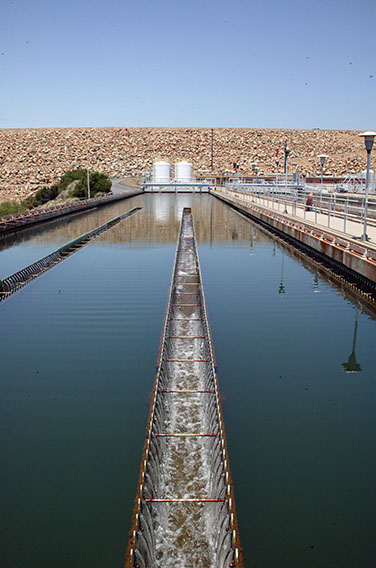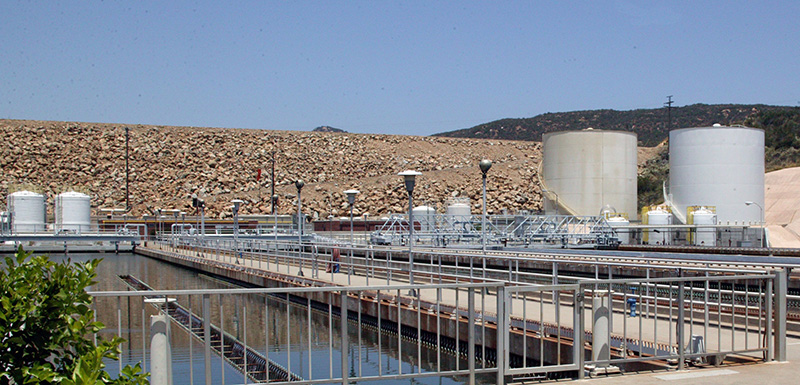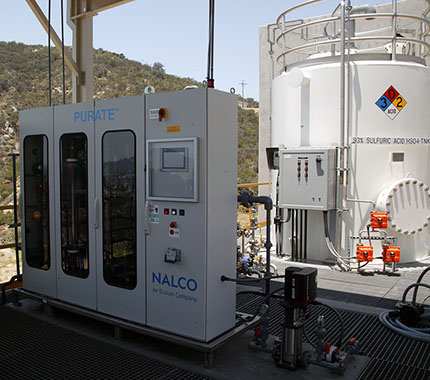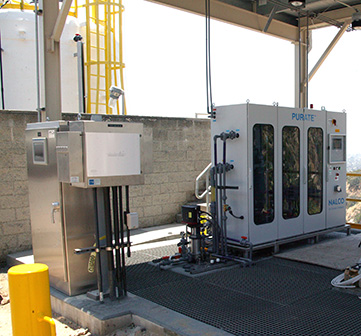Municipal Water Treatment
In the US and throughout the world, ever increasing demand for good quality, high purity water has led to strict regulations covering everything from disinfection by-products created by the addition of chlorine, to metals such as lead and copper that can leach into the water supply from corroding distribution system piping. There are now regulations in the US that extend to even cover the aesthetic properties of drinking water such as color, and taste & odor.
Material
ORP (Volts)
Oxidation Capacity
Ozone (O3)
2.07
2 Electrons
Hydrogen Peroxide (H2O2)
1.76
2 Electrons
Hypochlorous Acid (HOCl)
1.49
2 Electrons
Chlorine (Cl2)
1.36
2 Electrons
Hypobromous Acid (HOBr)
1.33
2 Electrons
ClO2 (Liquid Phase)
0.95
5 Electrons
Although Chlorine Dioxide has been in use to treat municipal drinking water for decades, these ever tightening guidelines have led more and more municipalities to turn to chlorine dioxide due to its many unique features as an oxidizer and disinfectant. In some cases, chlorine dioxide is the only viable technology that is practically able to help municipal drinking water plants meet current EPA guidelines. As human, agricultural, and industrial demand continues to grow and stress existing water supplies, the need for innovative water treatment solutions will certainly also continue to grow.
While there are a variety of methods commercially available to generate chlorine dioxide, not all generation methods are alike. The generation method used for treating water that is meant for human consumption, is extremely important. Consideration should be given to different methods depending upon the volume of water being treated, raw water quality, application, and existing infrastructure. In the majority of cases, Water Solutions recommends Nalco’s Purate® based process and SVP-Pure family of chlorine dioxide generators for treating municipal drinking water.
What’s different about Purate and the SVP-Pure generators?
Purate® is Nalco’s new, patented technology for the generation of chlorine dioxide. When used in conjunction with the SVP-PURE® (Single Vessel Process) generator, Purate® provides a safe and reliable method for producing a chlorine free source of chlorine dioxide. The Purate® system is based on the following patented chemical process:
NaClO3 + 1/2 H2O2 + 1/2 H2SO4 → ClO2 + 1/2 O2 + 1/2 NaSO4 + H2O
(Sodium chlorate) + (hydrogen peroxide) + (sulfuric acid) → (chlorine dioxide) + (oxygen) + (sodium sulfate) + (water)
As North America’s oldest and largest distributor of Purate based chlorine dioxide, Water Solutions has extensive experience retrofitting chlorine dioxide into existing municipal drinking water treatment plants. Our technical support staff are among the most experienced experts on the design and installation of on-site chlorine dioxide production systems in the world. We also have Association of Water Technologies Certified Water Technologists on staff, the highest professional accreditation in the water treatment industry, to help evaluate whether chlorine dioxide can be of benefit to you and how best to apply it for specific needs. Please contact us today to arrange to meet with one of our application engineers to see if chlorine dioxide could be right for you.
Here are just some of the many unique features of chlorine dioxide:
- ClO2 is a true gas in solution, and is therefore 100% available and does not lose any biocidal efficacy over the broad 3–10 pH range.
- Several papers have documented that weaker oxidizers such as ClO2 are much better than strong oxidizers at biofilm penetration and destruction. For this reason, ClO2 can remove and control biofilm better than any strong oxidizer including chlorine, ozone, and bromine.
- ClO2 has a higher oxidizing capacity and lower oxidation potential than other oxidizers. A unique feature of ClO2 is its ability to accept 5 electrons in an oxidation/reduction reaction versus 2 electrons for ozone, chlorine and bromine. At the same time it has a relatively low oxidation potential (ease of reactivity). This makes ClO2 available to function as a biocide, instead of getting "used up" before it gets to the target microorganisms.
- ClO2 penetrates the cell wall of the microorganism and disrupts metabolic functions of the cell. This process is more efficient than other oxidizers that "burn" whatever they come in contact with. This also allows for the use of lower effective biocide concentrations.
- Due to the way ClO2 works, microorganisms cannot develop an immunity to ClO2.
- ClO2 is a selective oxidizer that only reacts with certain organic compounds, and unlike chlorine, bromine, and ozone, chlorine dioxide does not attack most water treatment compounds.
- ClO2 is non-reactive with ammonia.
- Bacterial recovery (the regrowth of the bacteria after sanitation) is slower with ClO2 than any other oxidizer.
- ClO2, like ozone, is a dissolved gas that penetrates biofilm by molecular diffusion. Unlike ozone, ClO2 reacts slowly, allowing time for it to travel to the base of the film where it attacks the microorganisms and destroys the biofilm at its point of attachment. Strong oxidizers react mostly at the surface of the biofilm to form an oxidized layer, like charring on wood. This “burning” effect prevents further penetration and protects the underlying layer of biofilm from the biocidal agent in the bulk water.
- ClO2 has been shown to be more effective than copper sulfate in controlling algae. ClO2 attacks the pyrrole rings of the chlorophyll. This attack cleaves the ring, which inactivates the chlorophyll. In comparison, chlorine and bromine have a limited impact on algae.
- ClO2 readily oxidizes manganese and iron. Unlike chlorine and other halogen type oxidizers, the reaction time for chlorine dioxide to precipitate is short, less than five minutes. Chlorine will take up to 24 hours to react, and the reaction will still not go to completion. Furthermore, ClO2 will also quickly oxidize organically bound metals insuring complete removal down to PPB levels and eliminating post precipitation issues common with other oxidizing chemistries.
- Chlorine dioxide is a widely used and a very effective bleaching agent and will remove color faster and more completely than chlorine.
- Chlorine dioxide is a 160% weaker oxidant (less corrosive) than chlorine, but has a 250% greater oxidation capacity than ozone. ORP (Oxidation-Reduction Potential) is a measure of the strength of an oxidizer with regard to an oxidizable material and can indicate the relative corrosivity of a material. Oxidation Capacity is the measure of how many electrons can be transferred in an oxidation/reduction reaction. The table below is a chart of ORP & Oxidation Capacity for several common oxidizers.
Chlorine dioxide is widely used for odor control and will quickly and safely oxidize many compounds for taste and odor control such as phenols. When chlorine reacts with phenols, it forms chlorophenols, which have a worse taste and odor profile than phenols. When chlorine dioxide is used to destroy phenols, no chlorophenols are produced.
As North America’s largest and most innovative supplier of chlorine dioxide systems, let Water Solutions unparalleled experience, water treatment know how, and expert technical support help your facility realize the many benefits chlorine dioxide has to offer. Contact us today to arrange to meet with one of our application engineers.




There are two precursors required to generate chlorine dioxide via the above reaction, Purate®, Nalco’s trade name for its sodium chlorate/hydrogen peroxide blend, and 78% (by weight) sulfuric acid. Since this reaction neither requires nor produces chlorine (gas or liquid), it is the only truly chlorine-free process for generating large quantities of chlorine dioxide. Using Nalco’s SVP-PURE® generator, this process produces a safe concentration of ClO2 in an aqueous solution that is suitable for a wide variety of applications.
Other production methods produce chlorine dioxide using sodium chlorite and chlorine gas, or sodium chlorite and hydrochloric acid, or sodium chlorite, acid, and bleach. Since chlorite ClO2 generators are configured to intentionally overfeed chlorine and/or acid, to insure complete conversion of sodium chlorite to ClO2, you may end up with a witches brew of chlorine dioxide, unreacted acid, and unreacted chlorine rather than pure ClO2. This excess chlorine can then react with naturally occurring organics in the raw water, creating undesirable disinfection by products. Furthermore, since water treated with ClO2 must be tested for chlorite in the finished water, with an MCL of 1.0 ppm, should any sodium chlorite not fully react in the generation process, it will add to chlorite residuals in the finished water possibly leading to an exceedance of the 1.0 ppm MCL for chlorite.
With the Purate process, Purate and 78% sulfuric acid are reacted in undiluted form in the base of the reaction column producing pure ClO2 gas, oxygen, and a small amount of sodium sulfate. It is impossible for either unreacted chlorite or unreacted chlorine to enter the treated water from ClO2 addition. Lastly but not least, chlorine dioxide generated using the Purate method is typically 25% to 30% less expensive on a per pound produced basis than chlorine dioxide produced using sodium chlorite.
© AZURE WATER SERVICES, LLC — 2024 — ALL RIGHTS RESERVED
